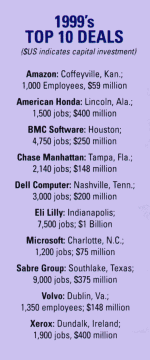If you build it, will they dot.com? Not necessarily. More accurately, if you dot.com it, you’d better build. 1999, you see, was the year in which some of the Internet’s leading lights decided that they needed big-time bricks to make their clicks work.
That concrete lesson in real estate realities is part of the story behind Site Selection‘s top 10 deals for 1999. Net-centric players like Amazon and Sabre Group are sprinkled throughout the list.
But that’s only one of the strategic drivers among 1999’s top 10 deals.
For example, many of these 10 projects, particularly in manufacturing, employed fast-track strategies to get huge spans of space online in a hurry. But while speed was also a common concern among these deals’ office contingent, creating quality work environments was the more dominant strategic thrust.
 With nine of the deals unfolding in the labor-starved USA, these 10 projects also pinpoint locations where some companies perceived what’s increasingly a U.S. rarity: ready labor.
With nine of the deals unfolding in the labor-starved USA, these 10 projects also pinpoint locations where some companies perceived what’s increasingly a U.S. rarity: ready labor.
Then there’s the equation’s other side: the area strategies employed to land these projects. Those schemes demonstrate a range of innovative solutions custom-designed to fit specific growth needs. And, yes, most fairly drip with multimillion-dollar incentives.
1999’s top deals also bring into question some conventional wisdom that gained considerable corporate real estate cachet a few years back. Information technology, the thinking went, had ended the need for centrality; smaller, broadly dispersed facilities were the future.
Not necessarily. While 1999’s top deals ranged far afield geographically, they arrived with resounding impact: The average project produced 3,334 jobs and a US$305.5 million capital investment. And most were sited with the idea of getting bigger, some a lot bigger.
Clearly, these projects placed a higher value on the strategic advantages of centrality, particularly knowledge-worker proximity, economies of scale and cross-functional synergies.
But Site Selection didn’t pick these deals simply because they’re big and earmarked by innovation and intense competition. Each also involved something rather plain and old-fashioned: a good story.